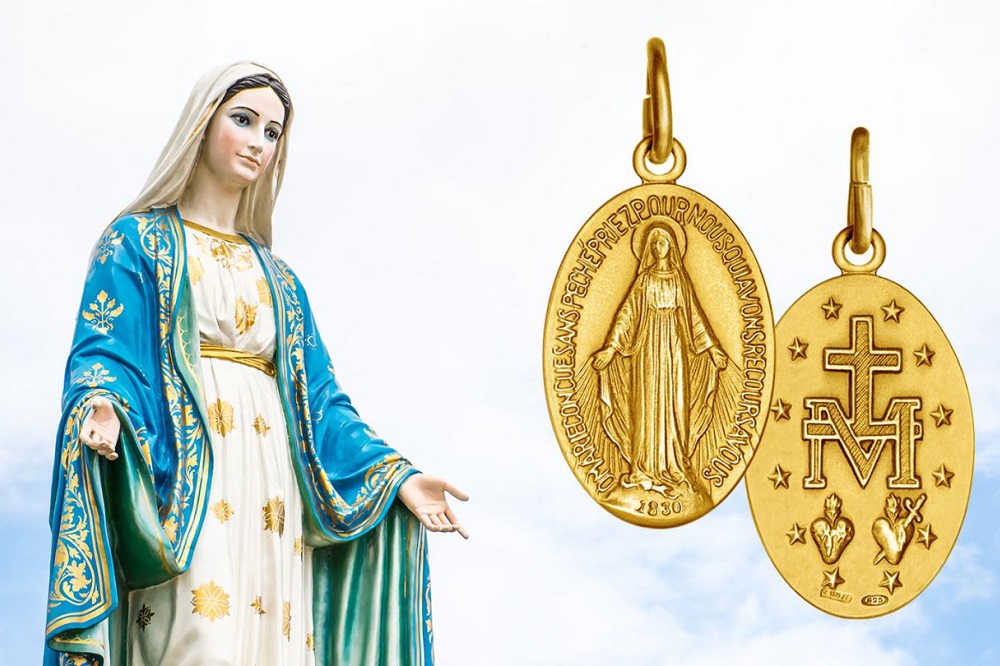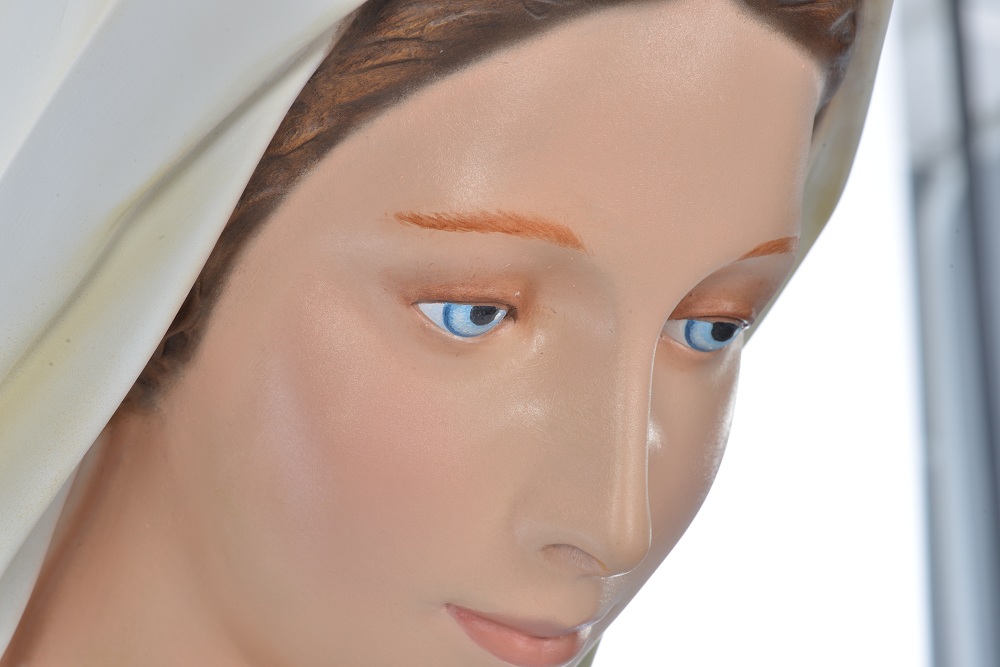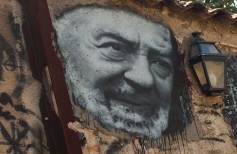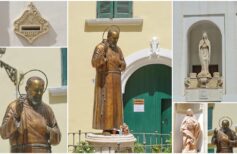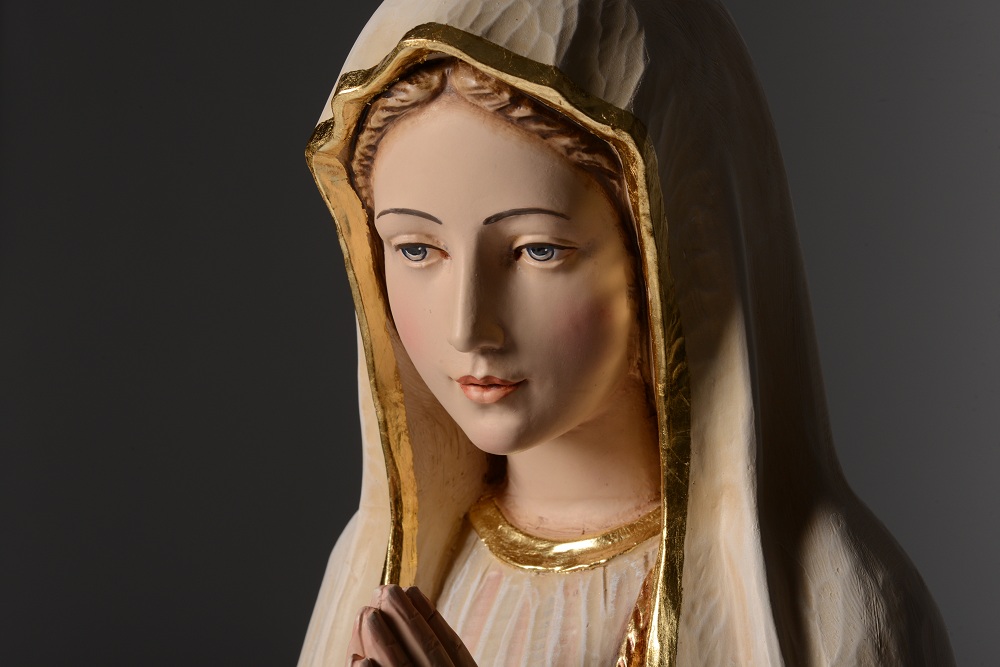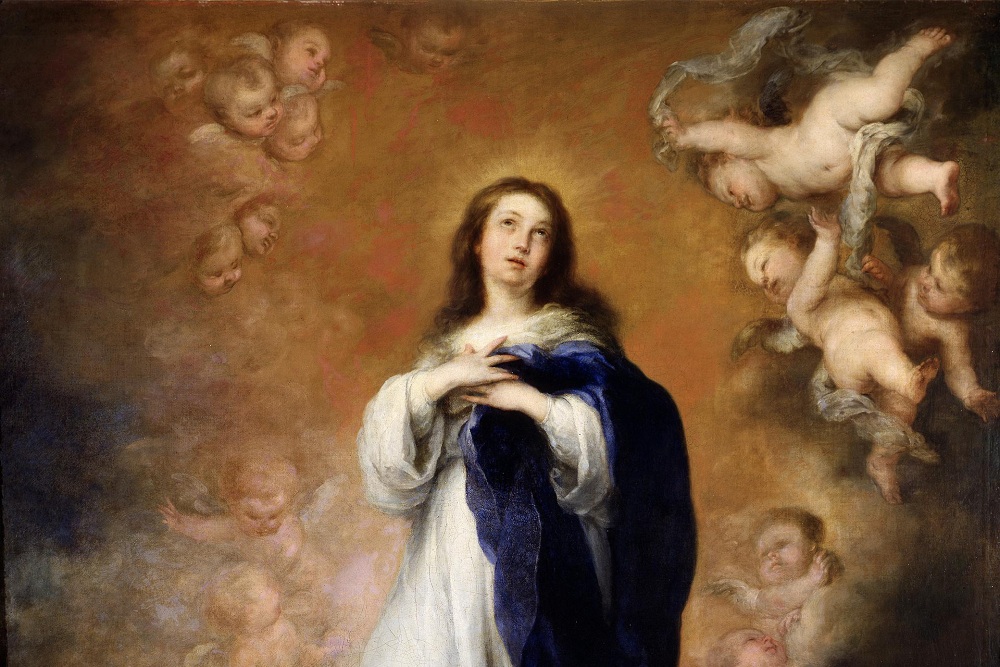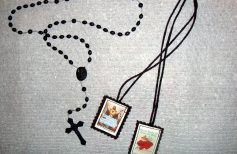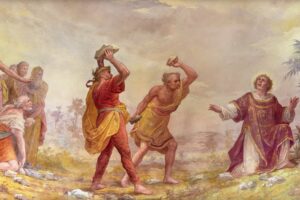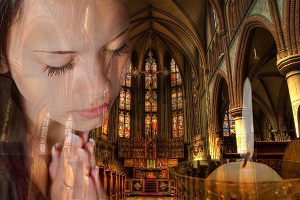The Miraculous Medal is a symbol of devotion and love recognized by the Catholic Church. It is a support for those looking for a grace, for those facing a hard time in their lives, or for those who just want to remember every day that they are not alone, and have an endlessly good and loving Mother supporting and sustaining them.
Contents
Catholicism recognizes the possibility that, throughout time, some particularly worthy men and women received the visits from Jesus, the Virgin Mary or a particular Saint. During these visits, these men would receive messages, revelations, and even orders, aimed at their own and the whole Christian community’s good. The nature itself of the Catholic religion, deeply focused on an interior dimension made of prayer and personal meditation, makes us understand how important visible, and sometimes even tangible, ‘signs’ are in it. Even though the soul is the preferred channel for the dialogue between man and God, the carnal and material nature of men sometimes demands for a manifestation of His presence on an existence level that is more suitable for men. During such apparitions, God’s love becomes visible, it turns into flesh, presence, a mystical experience that transcends every understanding and completely and irremediably shakes those who live it.
The story of the Miraculous Medal (or Medal of Our Lady of Graces, or Medal of the Immaculate Conception) relates to such experiences. This veneration object has a powerful symbolism, capable of unexpected healings and prodigious acts, and comes from an apparition, from a moment of divine love turned into flesh and light. It comes from the meeting of a young and humble novice aged twenty-four and the Virgin Mary, a night dialogue that lasted for hours, made not only of words but also of looks, gestures, displays of affections and devotions, and vibrant hope.
The Church in particular considers Mary’s apparitions as interventions from a loving Mother towards her children. They are an act of mercy and love from her, who, so close to God, does not forget those who live the anxieties of an earthly life, too fragile and weak to be able to face problems, adversities, and the many obstacles life gives them on their own. Therefore, Mary occasionally descends and reminds the believers and the faithful of her commitment, of her will to help men and women in their daily life, always supporting their cause in front of the Father.
That is what happened for the Madonna of the Miraculous Medal: on November 27th, 1830 she appeared to the future Saint Catherine Labouré, young nun of the congregation of the daughters of Charity of Saint Vincent de Paul in rue du Bac n. 140, Paris.
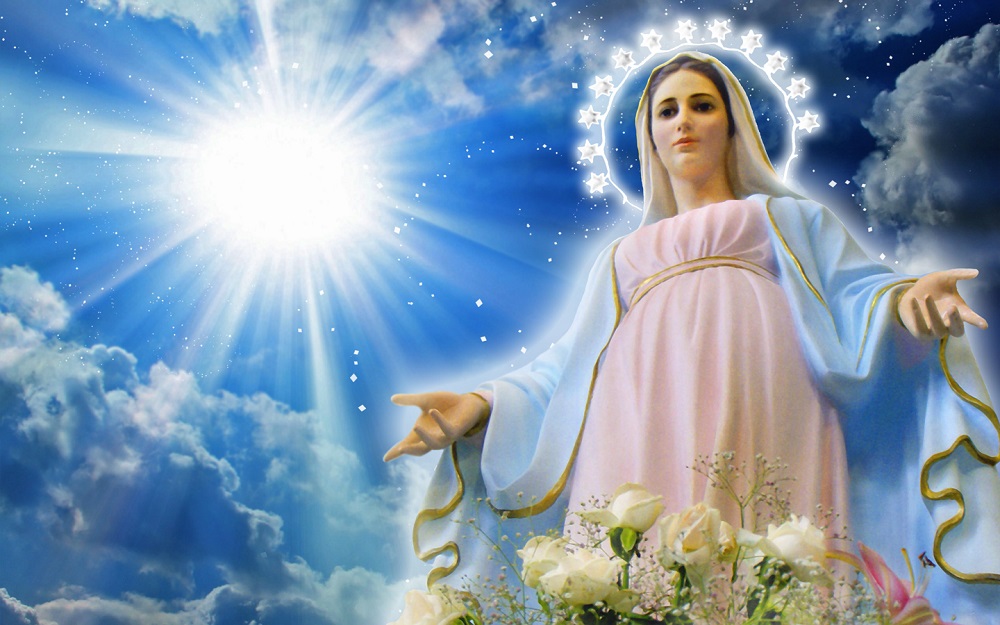
The apparitions and the story of the Miraculous Medal
Pope Pius XII sanctified Catherine Labouré in 1947; she said she witnessed many apparitions during her lifetime. The first happened when she was a teenager: Saint Vincent de Paul appeared in her dreams and invited her to enter his Congregation of the Daughters of Charity. She received more apparitions during her novitiate: she saw Jesus in the Eucharist beyond the appearance of Bread, and as Christ King crucified, deprived of all of his ornaments. She hid the apparitions for her whole life, telling them at the point of death only to her confessor.
The most famous apparitions Saint Catherine is famous for are the ones involving the Immaculate of the Miraculous Medal. They happened in July and November 1830 in the Novitiate Chapel. On July 18th 1830, Catherine had prayed Jesus with fervor in order to grant her wish to see the Virgin Mary. She woke up at 11.30PM because she heard someone calling her name, and saw a mysterious child in front of her bed, inviting her to get up. “The Virgin Mary is waiting for you” the child told her while emanating rays of light at each step. Catherine identified the child as her own guardian angel. He led her into the Chapel where Mary was waiting for her sitting on the right side of the altar. Catherine said: “Then, I flung myself close to her, falling on my knees on the altar steps, my hands resting in her knees. That was the sweetest moment of my life. It would be impossible for me to say what I felt. The Most Holy Virgin told me how I should behave with my confessor and many other things.”
When asked about the Virgin’s look, Saint Catherine could hardly find the words: “She was average height, and so beautiful that I cannot describe her. She was standing, her dress was sunrise-white silk and “virgin style”, that is, high-necked and with smooth sleeves. A white veil went down from her head to her feet. Her hair was divided and she wore some kind of bonnet with a 3 centimeters wide crochet on it, gently laid on her hair. Her face was quite visible; her feet were upon a globe, or better, a half-globe, or at least I saw half of it.” The Saint said she had kneeled in front of Mary and rested her hands on Mary’s knees as a reverence.
During the second apparition on November 27th 1830 around 5.30PM, the Virgin Mary entrusted Catherine with the forge of the Miraculous Medal. The Virgin said that the medal would be a sign of love, a pledge of protection and source of grace for those who would trust in it. The Virgin herself showed Catherine what the medal should look like. Catherine said that Mary’s feet were upon a half-globe during the apparition, which symbolizes the Earth, and were crushing a green and yellow snake’s head. The Virgin’s hands were adorned with rings and precious stones, which projected rays of light of different intensity and color downwards. Mary explained Catherine that those rays “symbolize the graces I shed upon those who ask for them“.
Catherine saw some kind of oval frame appearing around Mary, and a writing from her right hand to her left hand, creating a semicircle of words written in gold: “O Mary, conceived without sin, pray for us who have recourse to Thee“.
That became the front image of the Miraculous Medal: Mary crushing the Snake‘s head, as forewarned by the Bible (“And I will put enmity between you and the woman […] he will crush your head and you will strike his heel”, Gen 3,15). Rays of light shoot out from her hands, symbols of the graces granted by God, and the invocation “O Mary, conceived without sin, pray for us who have recourse to Thee” framing the whole picture.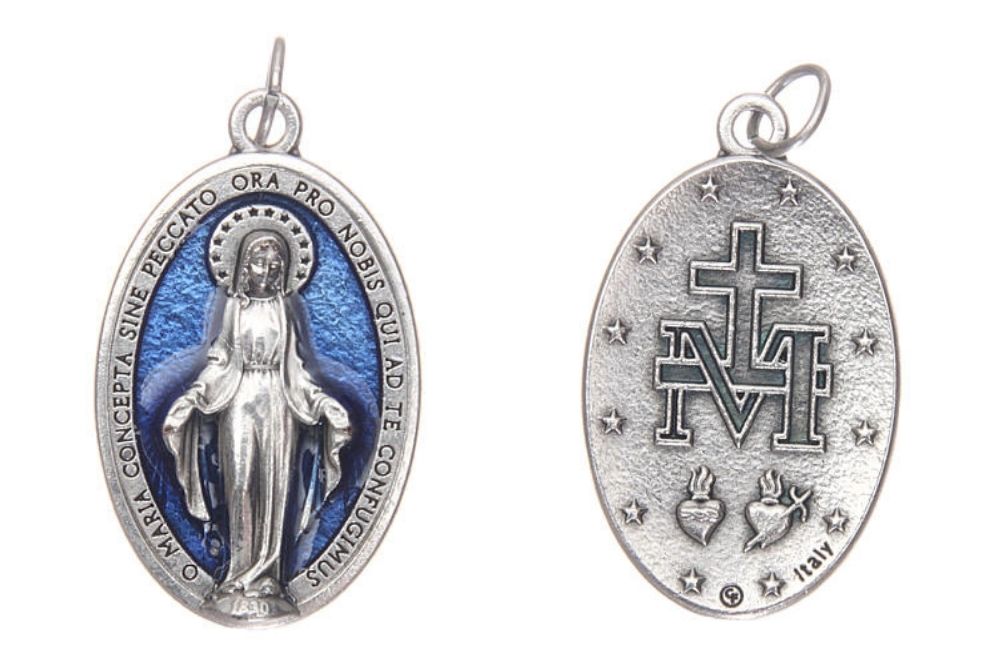
The apparition continued, and the mystic picture seemed rotating in front of Catherine’s eyes, showing her what the reverse side of the Medal should depict: “There was the letter M (first letter of the name Mary) topped by a cross with no crucifix and with the letter I (first letter of the name Iesus, Jesus) as base. Below there were two hearts, one was surrounded by thorns (Jesus’ heart), the other pierced by a sword (Mary’s heart). Twelve stars surrounded the whole picture. Then everything dissolved, as something that is switched off, and I was left there, full of something I don’t know, good feelings, joy, comfort“.
Here is the explanation of the reverse side of the Miraculous Medal: the M for Mary supports the cross without crucifix. The monogram I for Jesus (Iesus) intersects the M and the Cross, and symbolizes the salvation brought by Jesus and Mary, the indissoluble relationship that ties Jesus and his Most Holy Mother, becoming a witness of the Salvation of humankind carried out by his Son Jesus and making her a participant in Christ’s sacrifice. The heart crowned with thorns is the Sacred Heart of Jesus, while the heart pierced by a sword is the Immaculate Heart of Mary. The twelve stars symbolize the 12 tribes of Israel and the 12 apostles. The Virgin herself is also called Star of the sea in the prayer Ave Maris Stella.
The Virgin spoke again to Catherine, telling her to have a medal forged following that model: “All the people who will wear it will receive great graces especially if they wear it on their neck; graces will be generous for those who will wear it with trust.”
Catherine encountered some resistance, but in the end, the Medal was forged in 1832, in about 1500 pieces, but its power showed immediately through so many healings and conversions that it was necessary to forge a million pieces. Even Popes Gregory XVI and Pius IX used it and the Apparitions Chapel became a place of cult and pilgrimage.
Today we can find billions of reproductions of the Miraculous Medal, in gold, silver and less noble metals. We can find it in all religious articles shops, and of course in online stores.
The meanings of the Miraculous Medal: miraculous, shiny and painful
Miraculous
The Medal the Virgin suggested Saint Catherine so that she could have it forged and distributed is called miraculous Medal, referring to the many healings and conversions it caused. In February 1832, Paris was devastated by a terrible cholera epidemic, which caused more than 20.000 deaths. The Daughters of Charity distributed the first 2000 medals in that occasions, and healings began to show right away, along with conversions. That is why Parisians began to call it ‘miraculous’.
Shiny
The rays of light shooting out from Mary’s rings are the symbol of the graces she grants to all of her children and of her loving mission as intermediary between man and God. The rays of grace falling on Earth spread out love and salvation, and the light they emanate symbolizes Mary’s triumph, the first among those who were and will be saved, immaculate since her conception, bringer of a special grace thanks to the Son she carried in her womb. In this role of Mother and Savior, Mary kills the snake, cause of all humankind’s evil.
Painful
On the reverse side of the medal there are two monograms, of Mary and Jesus, their hearts are pierced; they tell a never-ending story of pain and love and sacrifice. In particular, Jesus’ heart crowned with thorns symbolizes His sacrifice of love for men, while his Mother’s heart, pierced by a sword, symbolizes Christ’s love, who lives and burns within her, and through her it transfers on all humankind.
The Novena to the Miraculous Medal
November 27th, the day Catherine received the visit and the mandate to forge the Miraculous Medal from the Virgin Mary, is the day we celebrate the Blessed Virgin Mary of the Miraculous Medal. For this important date, the Novena to the Miraculous Medal was written, and it must be recited from November 18th to 26th, and anytime we request graces and consecrations. The Novena of the Miraculous Medal should also be recited on November 27th at 5.30PM, the exact time the apparition happened, and while preparing for the feasts of the last Sunday of June.
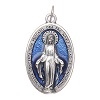
O Mary, conceived without sin, pray for us who have recourse to thee!
O most compassionate Virgin Mary, that never was it known that anyone who fled to your protection, implored your assistance, or sought your intercession, was left unaided. Inspired with this confidence, I fly unto you, O Virgin of Virgins, my Mother. To you I come; before you I kneel sinful and sorrowful. O Mother of the Word Incarnate, despise not my petitions, but in your clemency hear and answer them. Salve Regina. O Mary, conceived without sin, pray for us who have recourse to thee!
O Immaculate Virgin Mary, Mother of Our Lord Jesus and my Mother, penetrated with the most lively confidence in your all-powerful and never-failing intercession, manifested so often through the Miraculous Medal. I, your loving and trustful child, implore you to obtain for me the graces and favors I ask during this Novena, if they be beneficial to my immortal soul, and the souls for whom I pray. Salve Regina. O Mary, conceived without sin, pray for us who have recourse to thee!
You know, O Mary, how often my soul has been the sanctuary of your Son who hates iniquity. Obtain for me then a deep hatred of sin and that purity of heart which will attach me to God alone so that my every thought, word and deed may tend to His greater glory. Obtain for me also a spirit of prayer and self-denial that I may recover by penance what I have lost by sin and at length attain to that blessed abode where you are the Queen of angels and of all people. Salve Regina.
O Mary, conceived without sin, pray for us who have recourse to thee!
Once the Novena is finished, on the 27th during the Mass we recite the Act of Consecration
O Mary, conceived without sin, Mother of God and Mother of men,
disciple of Jesus Christ, thou are blessed among all women
and all generations proclaim you blessed.
O Virgin Mother of God, Mary Immaculate,
we dedicate and consecrate ourselves to you
under the title of Our Lady of the Miraculous Medal.
May this Medal be for each one of us
a sure sign of your affection for us
and a constant reminder of our duties towards you.
Ever while wearing it,
may we be blessed by your loving protection
and preserved in the grace of your Son.
O most powerful Virgin,
Mother of our Saviour,
keep us close to you every moment of our lives.
Obtain for us, your children, the grace of a happy death;
so that, in union with you,
we may enjoy the bliss of heaven forever.
O, Mary conceived without sin.
Pray for us who have recourse to thee. (3x)
The devotees can also choose to recite the Crown of the Miraculous Medal, which can be the opening for the Rosary or recited as Novena or Triduum before the 27th day of each month, especially in November. The crown of the Miraculous Medal is composed of an opening prayer, the recital of the Credo in its short version, and three pleas alternated with three Hail Mary. It closes with a final Prayer, a Pater, an Ave and a Glory to the Father.

